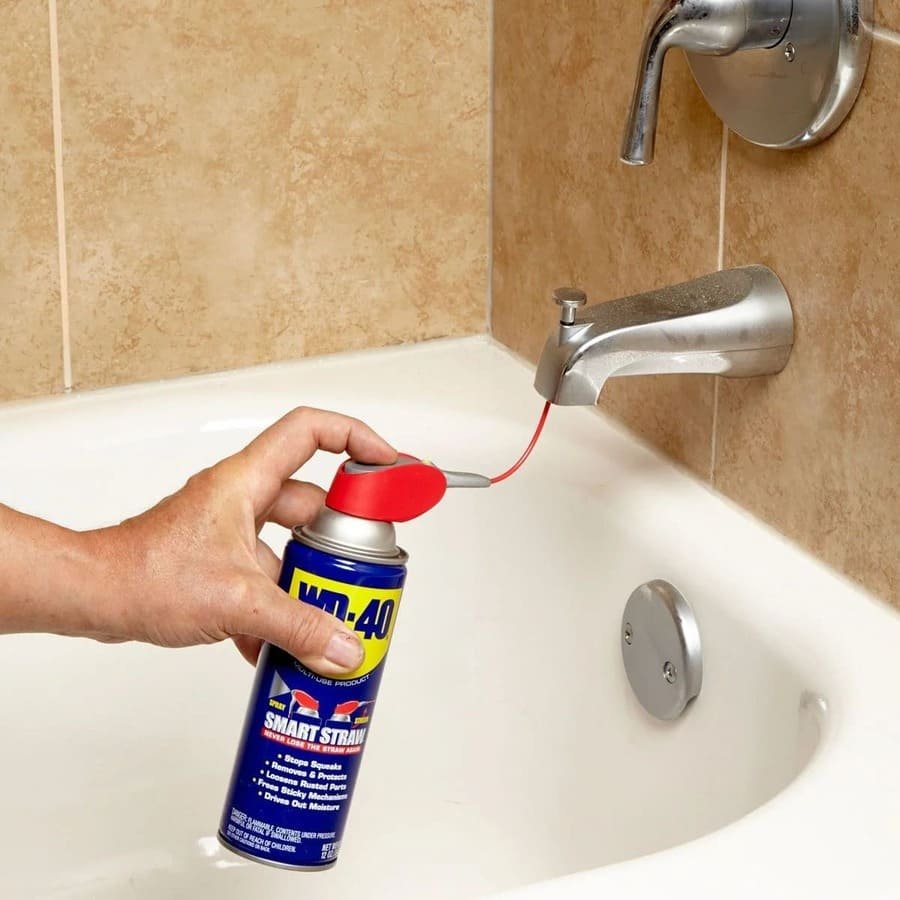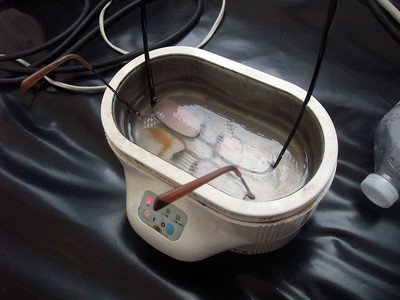Let’s face it — faucets are the unsung heroes of our homes. They’re used daily, yet they rarely get the TLC they deserve until something goes wrong.
Whether it’s a squeaky handle, a clogged spout, or a rusty exterior, these small annoyances can disrupt your day and tempt you to call in a pricey plumber. But hold on — before you pick up the phone, grab a can of WD-40. Yep, that little blue and yellow can in your garage isn’t just for squeaky hinges. It might just be the secret weapon your faucets are crying out for.
Here’s why.
1. Unsticking a Jammed Handle
Picture this: It’s early morning, you’re half-asleep, and you just want to wash your face. But the faucet handle? It won’t budge. You twist, you turn, you mutter a few choice words — but nothing. That stubborn handle is likely stuck due to rust or mineral buildup inside.
But hey, don’t panic! Before you resign yourself to calling a plumber or wrestling with it until your wrist aches, grab a can of WD-40. Trust me, it’s a lifesaver. Aim a quick spritz directly at the base of the handle where the mechanism connects, letting the magical lubricant do its thing. Let it work its magic for a few minutes, then try again. Chances are, it’ll glide like butter.
Wondering how this happened? Well, WD-40 comes to the rescue by acting as a lubricant and rust penetrant. It breaks down the rust and mineral deposits, loosening the stuck components. Here’s why it’s effective:
- Penetrates and Loosens: WD-40’s formula penetrates tight spots, which helps loosen rusted or gummed-up parts, making them easier to move.
- Lubricates: It also provides lubrication, reducing the friction between moving parts, which allows the handle to operate smoothly.
2. Eliminating Annoying Squeaks
There’s nothing worse than a faucet that screams every time you turn it. It’s like nails on a chalkboard, and it’s the last thing you need in your peaceful home. The culprit? Friction between metal parts. The solution? WD-40, of course!
Start by grabbing your trusty can of WD-40 and giving it a small spray around the moving parts of the faucet. Don’t go overboard — just a quick spritz will do. Next, gently wiggle the handle back and forth to help the lubricant spread and work its way into all the tight spaces. You might even hear that friction easing up as you move the handle. And then, voilà — silence. The irritating squeal is gone, replaced by smooth, soundless operation.
WD-40 is excellent for silencing these squeaks because:
- Lubricates the Friction Points: By spraying WD-40 on the moving parts inside the faucet, it reduces friction, thus eliminating the squeaking sound.
- Prevents Further Wear: The lubricant doesn’t just silence the noise — it also reduces wear and tear on the metal parts, extending the lifespan of your faucet.
- Easy Application: A simple spritz on the handle or any metal-to-metal contact points will usually silence the squeak almost immediately.
3. Removing Stubborn Mineral Deposits
Hard water is the villain we all love to hate. Those ugly white or green crusty deposits that form around your faucet aren’t just an eyesore; they can actually mess with its functionality. Enter WD-40. Spray it generously on the affected areas, let it sit for 10 minutes (patience is key), and then scrub gently with a soft cloth or brush. Rinse thoroughly, and prepare to be amazed. It’s like giving your faucet a makeover — no harsh chemicals, no fancy products, just a little ingenuity.
WD-40 effectively combats this problem by:
- Breaking Down Mineral Build-up: WD-40’s formula helps break down the bonds between the minerals and the faucet’s surface, loosening the crusty buildup.
- Non-Abrasive Cleaning: Unlike harsh chemicals or abrasive cleaners, WD-40 won’t scratch or damage the faucet’s surface. It’s gentle yet powerful enough to lift off the minerals.
4. Protecting Against Rust
Your faucet braves a constant barrage of water, humidity, and grime. It’s no wonder rust eventually makes an appearance. But don’t let rust win! A light coat of WD-40 can act as a protective shield, preventing rust from taking hold in the first place. Apply it every now and then, especially in bathrooms or kitchens where moisture levels are high. Think of it as an armor suit for your faucet — practical and stylish.
WD-40 serves as a protective barrier against rust because:
- Water Repellent: It creates a thin, water-repellent layer on the surface of the faucet, preventing moisture from coming into contact with the metal parts and causing rust.
- Long-Lasting Protection: A light coating of WD-40 can provide ongoing protection against rust and corrosion, especially in humid or wet environments.
- Cost-Effective Solution: Applying WD-40 periodically to your faucets is much cheaper than having to replace rusty or corroded components. It acts as a preventative measure that helps extend the life of the faucet.
5. Loosening a Stuck Aerator
Ever tried to unscrew a faucet aerator and felt like you were arm-wrestling a gorilla? Yeah, same. Those tiny threads can get gunked up with mineral deposits, making them impossible to budge. But here’s a trick: Spray some WD-40 on the threads, let it sit for a few minutes, and then try again. It’ll come off like a dream. No more wrestling matches, no more scratched-up faucet heads. Just a quick fix that works every time.
Here’s how WD-40 helps with a stuck aerator:
- Penetrates Stubborn Deposits: WD-40’s formula works to break down the mineral deposits or grease that may be stuck to the aerator threads.
- Loosens Stuck Components: With just a few sprays, WD-40 will loosen the aerator, allowing you to unscrew it without putting excess strain on the faucet or damaging the parts.
- Prevents Damage: WD-40 helps avoid the common issue of damaging the aerator or faucet when trying to unscrew a stuck part. With its lubrication, you can easily twist it off without worrying about cracks or scratches.
6. Improving Water Flow

Low water pressure is the ultimate annoyance. If your faucet’s stream has gone from Niagara Falls to a sad trickle, debris and mineral buildup might be to blame. WD-40 to the rescue! Spray it directly into the faucet spout, let it loosen the gunk, and then run water to flush it out. You’ll be back to full power in no time. Bonus: You’ll save yourself the headache of dismantling the faucet entirely.
WD-40 can improve the water flow by:
- Clearing Blockages: Spraying WD-40 into the faucet’s spout helps break down any gunk or debris that’s clogging the flow of water.
- Enhancing Water Pressure: By clearing out the blockage, WD-40 ensures that water can flow freely, restoring the faucet’s original pressure and volume.
- Non-Destructive: WD-40 cleans the spout without damaging any internal components, unlike more invasive cleaning methods.
7. Making Installation and Repairs Easier
Whether you’re swapping out an old faucet or just tinkering with some parts, WD-40 can make the job a breeze. Apply it to threads, bolts, or any connections that need loosening or tightening. It’ll reduce friction, prevent damage, and save you a ton of time. It’s like having an extra set of hands — the kind that never gets tired or fumbles the wrench.
Applying WD-40 can make the process much easier by:
- Reducing Friction: WD-40 helps reduce friction between the threaded parts, allowing them to loosen or tighten with less effort.
- Preventing Damage: By lubricating the threads and joints, WD-40 prevents stripping or damaging the components while you work on them.
Wrapping It Up
WD-40 isn’t just a garage staple — it’s a household hero in disguise. From unsticking your faucet handles to improving water flow, it’s a quick, affordable, and surprisingly effective way to keep your faucets in top shape. So next time your faucet misbehaves, skip the plumber and grab that trusty can. Your faucets will thank you, and so will your wallet.
While WD-40 is a miracle worker for many faucet issues, it’s not a cure-all. A leaky faucet, for example, likely means you need to replace a washer or seal. Similarly, extensive rust or serious damage might require a full replacement. So to put it simply, think of WD-40 as your first line of defense, not your final solution.



